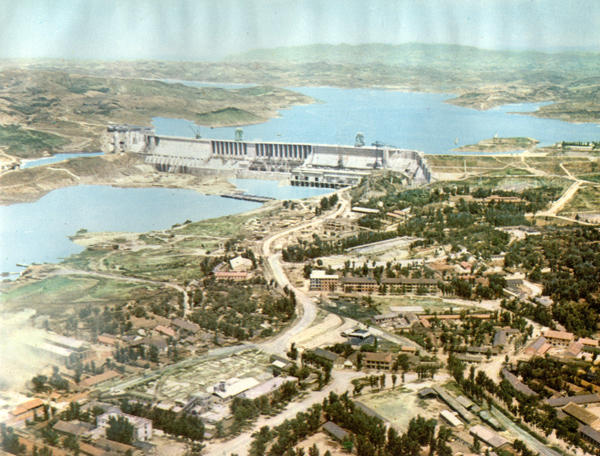 |
|
File photo of Danjiangkou Reservoir Dam and Danjiangkou city in 1970s. [Photo/Xinhua] |
In the winter of 1965, the then 11-year-old Ding Lixian was brought by his father to see Danjiangkou Reservoir Dams under construction. Taking a boat upstream, Ding saw half of the demolished ancient city walls without a single soul in it.
It is the first time and the last time for Ding to see Junzhou Ancient City before it was submerged. On the way, Ding's father kept silent. It was not till several years later that Ding understood his father's silence.
On the water storage day in 1967, the 2,000-year-old Junzhou Ancient City was submerged by the flood.
Junzhou Ancient City was the birthplace of Taoism. In the early years of the Ming dynasty (1368 AD-1644 AD), Emperor Zhu Di built a royal Taoist temple on Wudang Mountain nearby and Jingle Palace in the city with high walls around. Jingle Palace, the most famous of the eight Taoist palaces in China, had an area of 50,000 square meters, taking up half of the ancient city and the walls were estimated to be 3.5 kilometers long.
In 1958, residents of Junzhou city started to move due to the construction of the Danjiangkou Reservoir Dams. Half of the ancient walls were torn down. For Jingle Palace, only a pair of stone turtles and a memorial archway were removed to the new city and the rest was abandoned.
Only the name of Junxian town, named in honor of the old city, serves as a reminder of the ancient city slumbering underwater.
Traditional industry shut downA large number of polluted factories have been shut down with little left to protect the quality of water in Danjiangkou Reservoir since 2000, said Wei Qingjiu, deputy director of the Danjiangkou environmental protection bureau.
Moreover, to ensure water safety, net cage fish farming will be prohibited by the end of 2015.
Net cage fish farming is one of the staple industries in the Danjiangkou Reservoir area. According to official statistics, there are 120,000 cages of fish valued at 680 million yuan ($110 million) in the city this year.
Jiang Decheng, a fish farmer, was born in a fishing family. He started net cage fish farming over 10 years ago and has 100 cages of fish.
Every year, Jiang feeds fish with hundreds of tons of fodder and delivers medicine to the fish for disease prevention.
Since water flows faster in the Reservoir, he has had to "deliver medicine to net cage fish as much as ten times more than fish farmed in a pond", said Jiang.
Water pollution caused by fish fodder and medicine has led authorities to shut down the industry.
As Wei Qingjiu said, to supply northern regions with clean water, "we sacrificed our most traditional industry".
Danjiangkou sacrificed its own development to support the south-north water diversion project. It is still classified as a "national-level poverty-stricken county".
Related news
South-north water diversion project starts to supply water to Beijing
